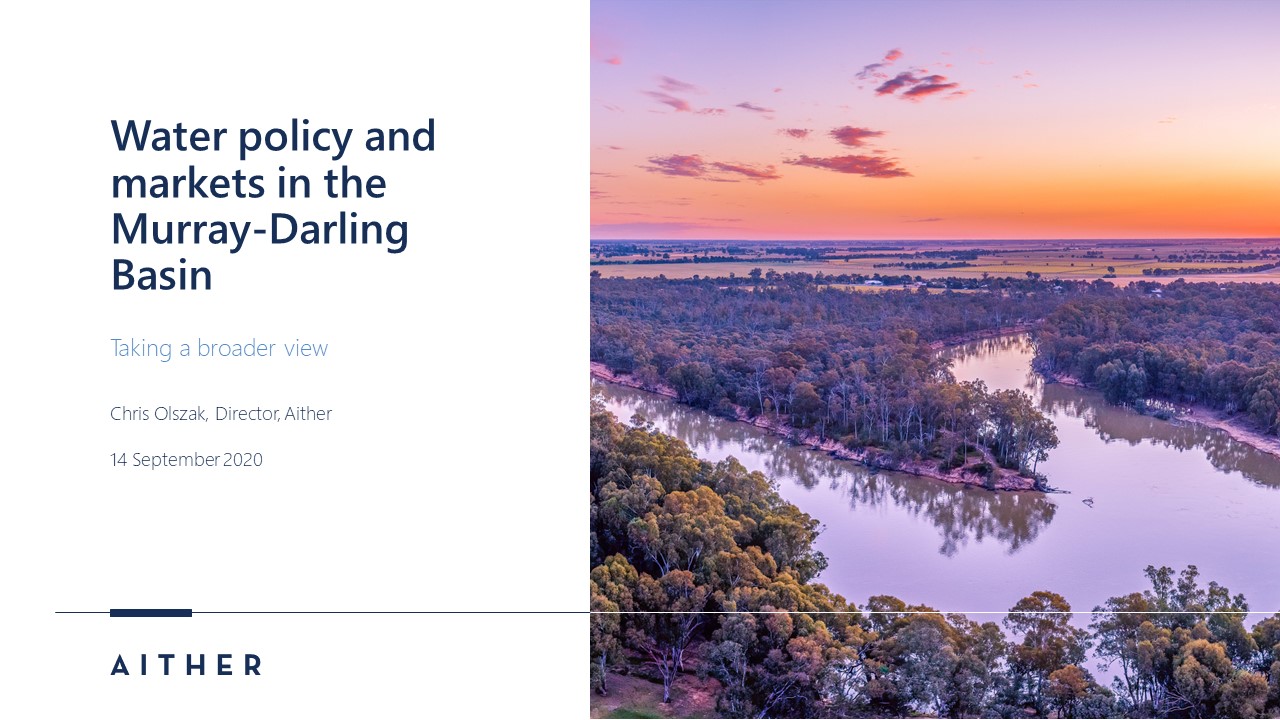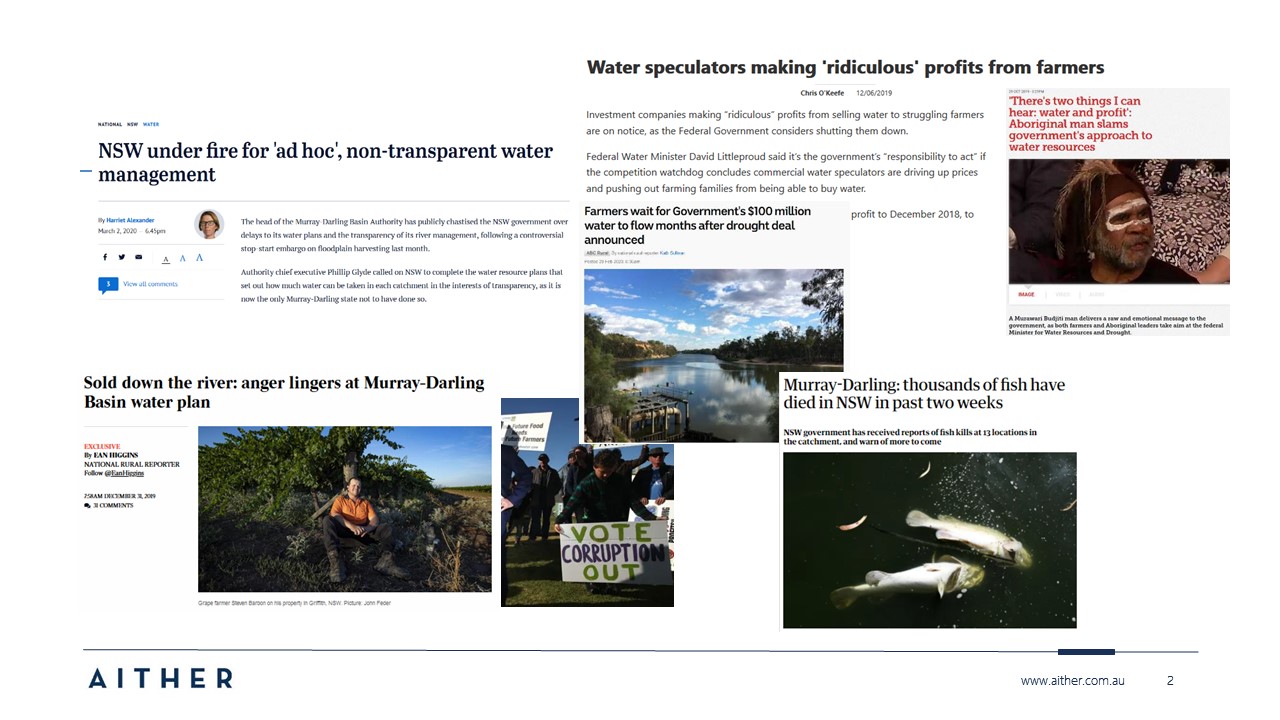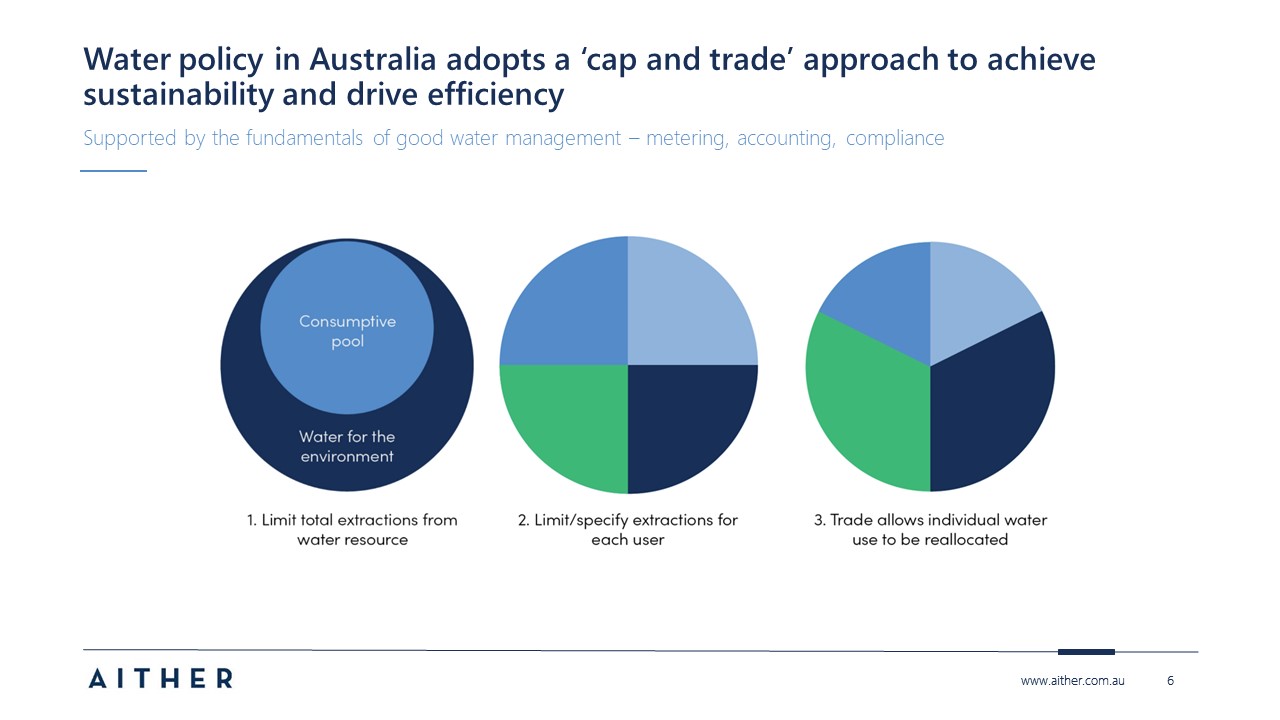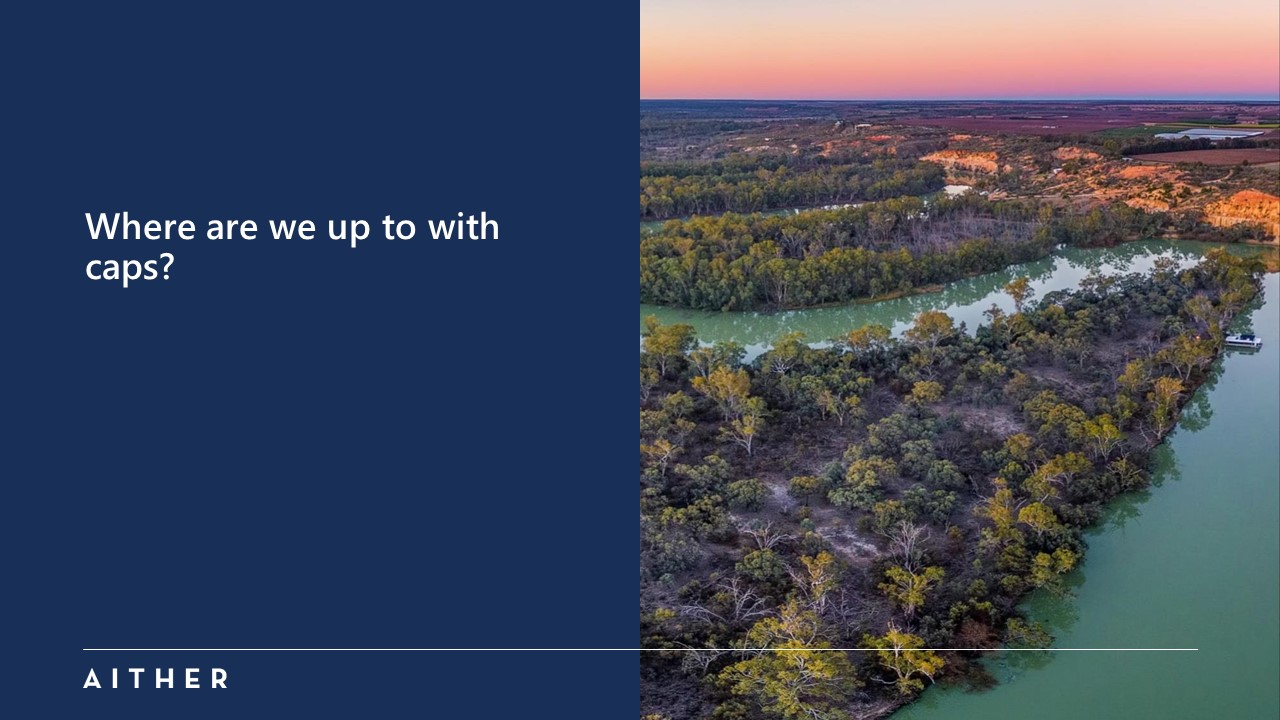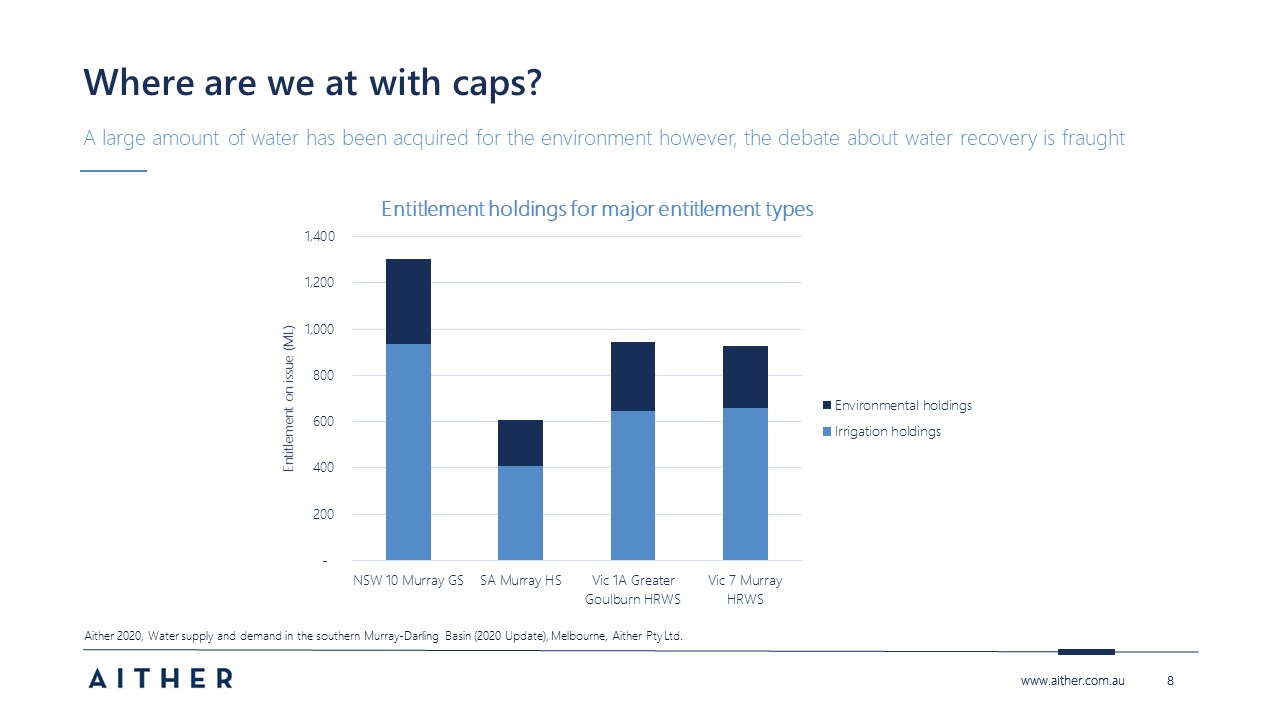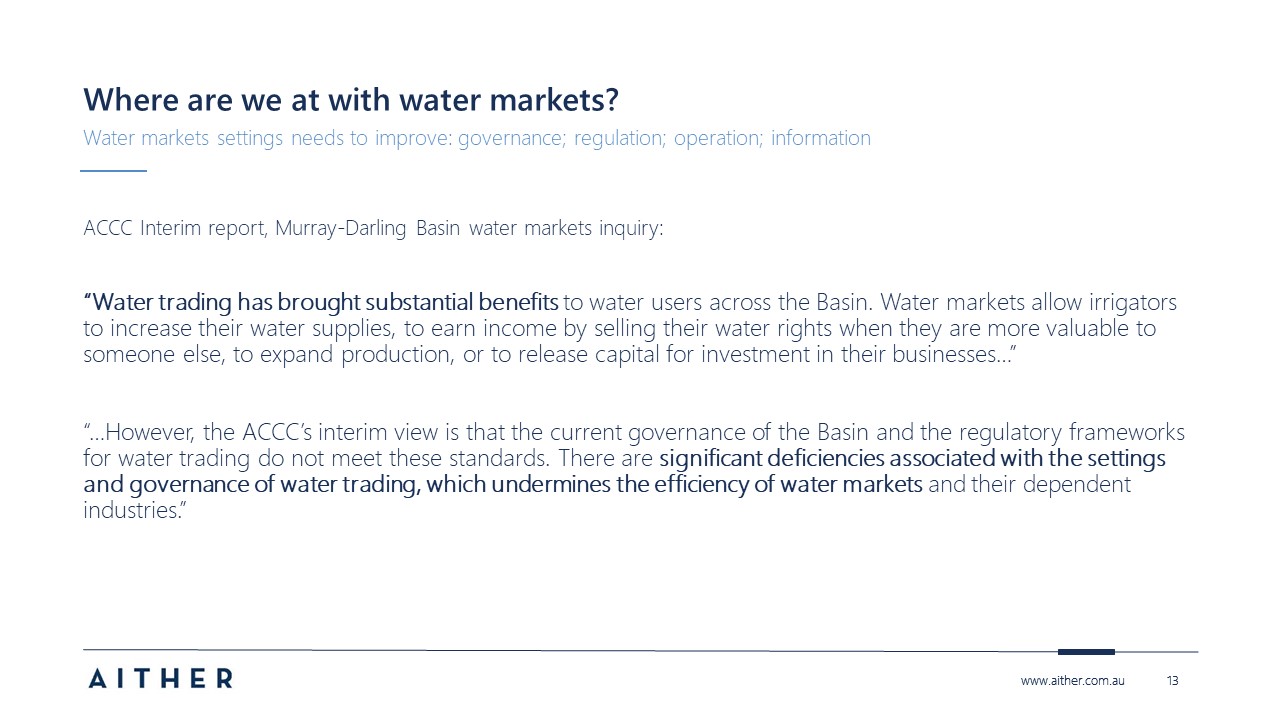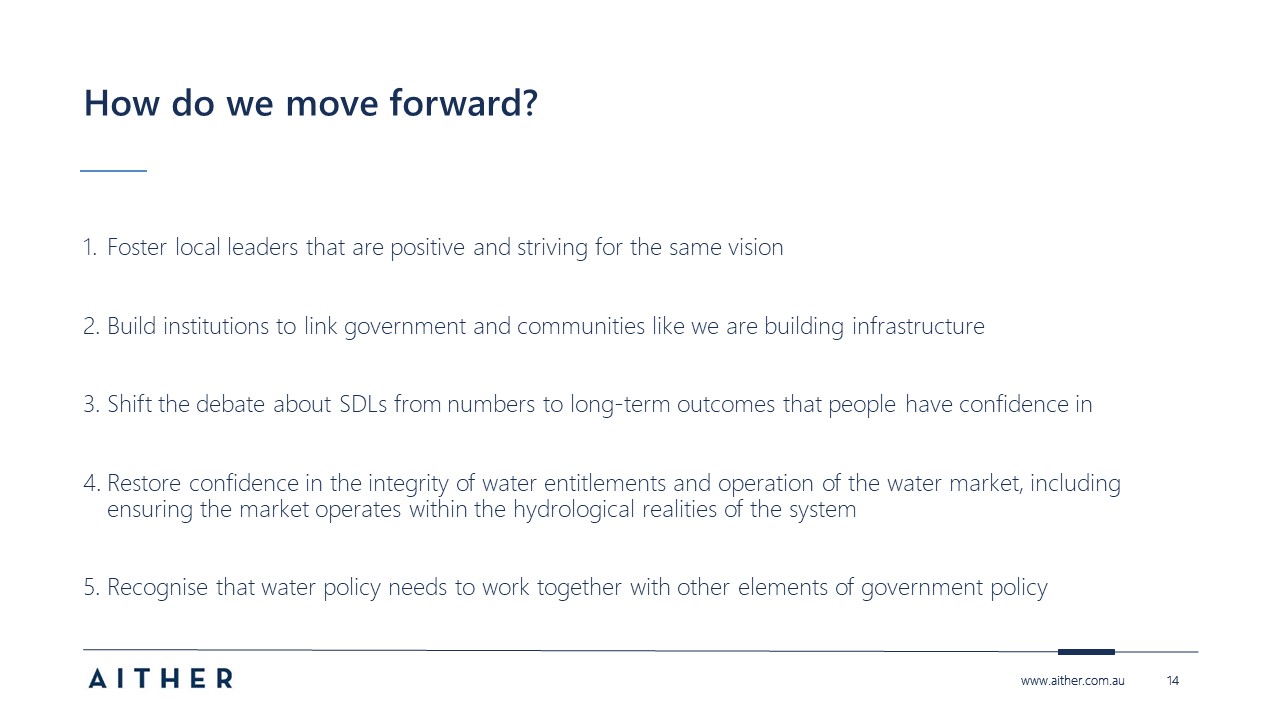You can view a recording of the presentation (begins at 1:12:00) or read the transcript and slides in full below. For more recordings of the Murray-Darling Association’s 76th Annual Conference and AGM please click here.
Thank you for having me, and a big thank you to Emma Bradbury and the Murray Darling Association for your passion and commitment in getting people together to discuss these important issues.
My name is Chris Olszak, I’m a founding Director of Aither.
We are an independent advisory firm that helps governments and businesses make better decisions about globally significant issues, including water management in the Murray Darling Basin. A key factor in many of you being here is that you realise that the Murray Darling Basin is undergoing unprecedented economic, social and environmental change. There’s a big opportunity for the future to be bright but also a risk that:
- The health of the river system deteriorates, threatening the many values of life on the rivers, not just the ecology
- That people and communities get left behind
- And that we fail to make the most of the MDB’s competitive advantage and massive opportunities in irrigated agriculture
In 20 years’ time, will the MDB be viewed as a failure? Or will there be thriving industries, businesses and communities, supported by, and contributing to, healthy and productive landscapes? It’s critical we get this right. And while water policy definitely isn’t the only thing that will determine success, it plays an important role.
I want to take a broad view in this presentation. The main messages I want to convey are that:
- Firstly, when you step back from the detail, government policy settings generally aim to support a positive vision for rural Australia – to me, the objectives are right.
- Secondly, the fundamentals of water policy have supported aspects of this vision and the fundamentals are sound, but implementation has been imperfect and subsequently, people have lost confidence. There is considerable effort required to get back on track and an absolute need to do so.
- The last point is that we need to recognize that getting water policy right isn’t going to change the trajectory of many social and economic forces affecting industries and communities – so other policy settings also need to play a major role. We need to accept that getting policy settings right isn’t about stopping change altogether.
I am optimistic, but I’m also realistic and fully aware of where we stand today.
As the Federal Water Minister Keith Pitt highlighted in his recent speech, and as found by the Independent Panel assessing social and economic conditions in the Basin; relationships have broken down. Trust and confidence in the integrity and effectiveness of water policy and markets is at a low point.
The tone and rhetoric is angry and confrontational. It becomes almost impossible to distil fact from fiction. The polarised debate is focused on problems, rather than building a constructive evidence base, and focusing on solutions and a positive yet honest way forward.
It’s taken a bit of rain, plus an unprecedented bushfire season and a global pandemic to push water management in the MDB out of the headlines, but the challenges haven’t gone away.
I’d like to use this opportunity to share some of my thoughts on water policy and management in the Basin and how this fits into the bigger picture – looking at:
- What we are trying to achieve in the Basin?
- Where are we at?
- And how do we move forward?
These are my personal views but have benefited from work done by my Aither colleagues.
Let’s start with what’re we’re trying to achieve. What goals have we set, and how have we gone about moving towards them?
Aither’s research and work across agricultural, drought, regional development and water and environmental policy highlights to us that governments at the state and federal level tend to have very similar objectives and visions.
All the language is broadly consistent with supporting resilient and adaptive businesses, industries and communities. With efficient resource use, supported by, and contributing to, healthy and productive landscapes.
These objectives reflect a nation-wide productivity and sustainability agenda that gained momentum in the 1980s and 90s, and which had a strong emphasis on the global competitiveness of agriculture.
In essence, there was a shift at this time from a hundred years of government led regional development and protectionist policies to a focus on moving to free and open competition with businesses driving their own destiny and standing on their own two feet. In short, governments saw their role as steering not rowing – providing the framework and rules for businesses to make decisions with confidence and certainty.
That’s the aim anyway, and that’s a big part of the goal of water policy. Policies and programs are meant to support the vision, and outcomes improved for everyone.
Focusing on water, the microeconomic reform agenda was articulated in the COAG water reform agreement in 1994 and the National Water Initiative in 2004.
In my opinion, The NWI still provides the light on the hill, with implementation aimed at a nationally-compatible, market, regulatory and planning based system of managing surface and groundwater resources for rural and urban use that optimises economic, social and environmental outcomes.
Essentially, water policy under the NWI adopted a “cap and trade approach” to meet these economic and environmental objectives. Despite all the talk about water being complex, the main elements are pretty simple:
Cap water extractions, based on what can be sustainably used, ensuring that this adjusts each year to the enormous variability in inflows to Australia’s river systems
Provide clearly specified property rights or water entitlements to users, giving them access to a share of the available consumptive pool
Allow those rights to be traded so that individual businesses can adjust and water can move to the highest and best use, subject to the constraints of the river system
If done correctly, and supported by metering and compliance, this system provides for efficient allocation of water and environmental sustainability. It also provides for equitable access to water, enables flexibility for individuals to respond to challenges and opportunities, and means that government is not on the hook for guaranteeing water supply when it simply can’t do so.
So where are we at in relation to this cap and trade approach? I’ll start with caps established under water plans.
Many of you will know that a total cap on extractions in the MDB was established in the 1990s.
This was a critical achievement in the shift to more secure and sustainable access to water. Before that, in some places, new developments could occur, and water licences could be granted that would simply reduce the reliability of everyone else’s licence or contribute to unsustainable use.
Aither increasingly works internationally and many countries can’t even contemplate this first most important step. Changing the paradigm to managing within system constraints, as opposed to pretending they don’t exist, changes everything that follows.
A key point with the initial cap though, is that it was set based on historical use, not what was deemed sustainable for the river system long-term.
The push for more sustainable limits on extraction gained in momentum through the 2000’s as the Millennium drought took hold. Basin wide efforts were made through The Living Murray First Step program. This program was just that – a first step in water recovery for the environment and states also took their own steps.
Then we had the Basin Plan. The Basin Plan not only came up with a number for what needed to be recovered to move extraction to within sustainable limits, it set up a system of adaptive management and oversight of state water resource management – to effectively keep the states honest.
We all know the history of water recovery efforts from here – a major entitlement buyback program which largely finished in 2012 combined with significant investment in on and off farm infrastructure to reduce system losses. And, clearly, a whole lot of controversy.
This chart shows the current entitlement holdings for four major entitlement types across Victoria, South Australia and NSW. It shows the split between entitlements held for the environment in dark blue and entitlements held for irrigation in light blue, as a result of water recovery under the Basin Plan.
So, a significant volume of entitlement has been recovered for the environment. In fact, around 20-30% of the entitlement in the southern Basin is now held by government environmental water holders.
From an environmental perspective, this is surely a huge achievement. About 2,100 GL of water has been recovered and, if the sustainable diversion limits offsets projects can be implemented, then we would get to the 2,750 GL target.
But it has come at a cost. And the cost isn’t just what government paid; it’s not just the economic cost in reduced irrigation production and any flow on social and economic impacts.
To me, the bigger cost is that people are more divided about the need for water for the environment, less convinced about the science behind the sustainable diversion limits, and less clear about the outcomes being achieved and pursued. What do you think? Has the Basin Plan got the balance right? Do you have the information and evidence to even come to a view?
In my view, good water planning and long-term certainty requires different stakeholders with different interests and values to all have a seat at the table and to actively participate in decision-making based on science and evidence; trying to find the balance, with local leaders bringing their communities along.
To me, as an observer, the Basin Plan has felt a pretty long way from that from the beginning. That’s not to cast blame on any individual or any particular agency, jurisdiction or stakeholder group. It is what it is. It’s what we do from here that matters now.
I’ll turn to water markets. Where are we at?
Largely, I think water markets are achieving their objectives. They allow for change to occur, they allow for exit and new development; they allow for new types of participants in the market; and allocation markets allow irrigators to deal with extreme climatic variability.
This chart shows allocation prices (the line), and the total volume of water allocated in the southern MDB over the last 13 years.
The main point is that allocation prices respond to supply. When there’s lots of water available, the price is low and vice versa. The market enables water to move to those who need it most, when they need it most.
Annual croppers can choose not to grow whereas horticulturalists have long lived assets. So, when the drought was in full swing last year, prices were close to $1000/ML – the annual croppers didn’t produce, and made more money with any little water they did have by selling it to desperate horticulturalists.
I’m sure the cotton grower would have preferred a full allocation and to grow cotton and I’m sure the horticulturalist would have liked to only pay $100/ML.
But this is the reality of water scarcity.
We have to live with the water available and that means hard decisions. The benefit of water markets is that we are much better off with individual farmers and businesses managing water risk on their farms, rather than governments.
The bigger picture story for water markets is that, over the last 15 years, markets have functioned in a period of rapid change.
We’ve had three severe droughts, and two of the wettest periods in the Basin’s history.
It appears that the climate has already changed. Murray system inflows have halved when you compare the last 20 years to the 100 years before that.
Combined with 20-30% of the water now held for the environment, there’s much less water to go around.
So supply has reduced, and yet demand – or willingness to pay for water at a given level of supply – has increased. That’s been driven by agricultural enterprises searching for new opportunities and accessing new markets, which is exactly what they’ve been encouraged to do.
We’ve seen a growth in permanent horticulture and greatly improved profitability in some horticultural commodities. We’ve also seen the emergence of cotton in the Murrumbidgee. And across the board, irrigators are becoming more efficient, either through public or privately funded investment, as well as improved management.
Water is valued and being valued.
And things have changed as a result. There’s no going back to the 80s and 90s. In the absence of a major economic collapse, demand for water is going to remain higher.
If you are an irrigator that’s still reliant on sub $100 per ML water to make money, it might be time to rethink your business model.
The reality is that some irrigation businesses won’t be able to survive all this. There’s just not enough water to go around.
Water scarcity – supply and demand – is the cause of this. Not the market. And stopping change isn’t the answer either if we want successful and resilient irrigation businesses and industries.
Critically, getting water policy settings right isn’t going to change other trends affecting rural areas. For example, agricultural sector employment has declined by about 25 per cent over 20 years, despite the gross value of agricultural production across Australia growing in real terms over same period. In the Basin, the gross value of irrigated agricultural production has also increased modestly in real terms over the same period.
Agriculture is more capital intensive and less labour intensive so the jobs of the future in agriculture will be different. This will have flow on impacts to communities regardless of what happens in water policy. These are long-run trends.
Water policy simply won’t solve that issue, it can’t be expected to, so we need to accept that. We need to look for other policies and opportunities to enhance the resilience of rural communities.
There’s also a big benefit in all this change for long-term irrigators that have held entitlements since before unbundling. In all the doom and gloom messaging, this story often goes untold.
The value of their assets – their water entitlements – has skyrocketed, particularly over the last 5-6 years as shown in this chart which plots monthly entitlement prices from 2007 onwards.
So, if an irrigator needs to exit, they will get much more for their water assets than they would have 5 years ago.
That’s not to say the market is working perfectly. For many years, we’ve been saying that the market settings aren’t keeping up with the degree of change and the pressure being placed on water markets.
The ACCC has highlighted that people have lost confidence in the integrity of the market, and significant enhancements are required.
The ACCC has comprehensively canvassed the issues and options and there appears to be the appetite to make sensible improvements. I’m hopeful that solutions can be developed and a road map put in place for implementation over time.
But everyone should be aware that whatever the ACCC recommends, and whatever gets implemented, it’s not going to change the reality of the forces driving higher water prices.
Beware of the purveyors of false hope.
So how do we move forward?
I certainly don’t have all the answers but I’ll suggest some of the ingredients for you to consider over the next few days and beyond.
The first suggestion lies in groups of people like yourselves. Getting real local leaders – businesses, governments, communities; indigenous groups and environmental groups back around the table talking about the long-term vision. It’s great that the MDA has this focus.
Positive, forward looking conversations are required where people are able to influence objectives, examine and understand trade-offs, while pursuing win-wins where possible. There needs to be something in it for everyone and a clear pathway forward.
Governments need to be transparent and held to account for delivering and should approach building institutions for community engagement and regional development like they are building infrastructure. They require investment, management, dedication and ongoing maintenance.
In relation to the specifics of water policy, the key to me lies in focusing on building confidence in the integrity of policy settings. We don’t need to throw the baby out with the bathwater.
We just need concerted effort to make it work better, to continually explain it to people, and to adapt as new challenges and evidence comes to bear.
Building confidence and integrity has many dimensions. It includes the science and economics behind the establishment of caps and river health; it includes the hydrology of running the rivers; it includes making sure that the water market rules work, are being followed, and reflect the realities of the physical river system. It means open and transparent water accounting and information and metering and compliance frameworks that leave no room for theft.
And lastly, again, we need to make policy decisions outside of water policy that are attuned to the challenges communities and industries are facing. This means looking at policies and programs across the intersection of water, environment, agriculture and community development.
The stakes are high and governments particularly need the resources to be able to do this job well, which is a big concern in the current economic environment.
In conclusion, I am optimistic.
Our water policy settings do aim to support an open and flexible economy, resilient and adaptive businesses and a healthy environment. To me, the objectives are right.
The fundamental tools of water policy can support this vision. But implementation and execution has been imperfect. Subsequently, the community has been lost along the way and debate has become polarised.
There is considerable effort required to get back on track and engagement of people and local leadership is key.
The final point to reiterate again is that getting water policy right isn’t going to alter the trajectory of many forces of change – so other policy settings need to play a major role.
Thank you for your time. It’s unfortunate that we couldn’t be in the same place for follow up discussions but I’m very open to feedback on these thoughts from today and very happy to engage in further discussions – please don’t hesitate to get in touch on my email.
Thanks.
Download the PDF version here


